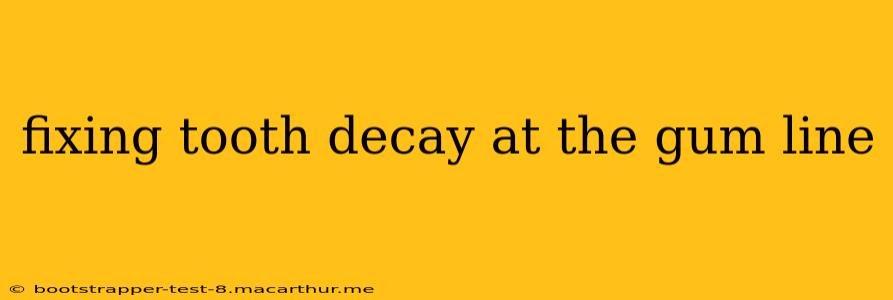Tooth decay at the gum line, also known as cervical caries, is a common dental problem that can lead to significant discomfort and even tooth loss if left untreated. This area is particularly vulnerable due to the thinner enamel and the presence of bacterial plaque accumulation. This comprehensive guide explores the causes, symptoms, diagnosis, and treatment options for gum line decay, answering frequently asked questions to provide a complete understanding of this dental issue.
What Causes Tooth Decay at the Gum Line?
Several factors contribute to the development of tooth decay at the gum line. These include:
- Receding Gums: As gums recede, the root surface, which has less protective enamel than the crown, becomes exposed, making it more susceptible to decay. This is often linked to periodontal disease (gum disease).
- Acidic Foods and Drinks: Frequent consumption of acidic beverages like soda and citrus juices weakens enamel, making it more prone to decay.
- Poor Oral Hygiene: Inadequate brushing and flossing allow plaque to accumulate, leading to the production of acids that erode tooth enamel.
- Bruxism (Teeth Grinding): Grinding your teeth can wear down enamel, especially at the gum line, leaving it vulnerable to decay.
- Dry Mouth: Saliva plays a crucial role in neutralizing acids and protecting teeth. Dry mouth reduces saliva production, increasing the risk of decay.
How Can I Tell If I Have Tooth Decay at the Gum Line?
Identifying gum line decay early is vital for successful treatment. Symptoms may include:
- Sensitivity to Hot and Cold: A sharp, shooting pain when consuming hot or cold foods or drinks often indicates decay near the gum line.
- Brown or Black Stains: Discoloration at the gum line might suggest the presence of decay.
- Discomfort When Biting: Pain or discomfort when chewing can indicate decay affecting the root surface.
- Visible Cavities: In some cases, cavities might be visible near the gum line.
What Are the Treatment Options for Tooth Decay at the Gum Line?
Treatment depends on the severity of the decay. Options include:
- Fluoride Treatments: For early-stage decay, fluoride treatments can help strengthen enamel and prevent further damage.
- Fillings: Small cavities can often be effectively filled with composite resin or amalgam fillings.
- Inlays/Onlays: For larger cavities, indirect restorations such as inlays or onlays might be necessary. These are made in a lab and are more durable than fillings.
- Crowns: Extensive decay may require the placement of a crown to protect and restore the affected tooth.
- Root Canal Treatment: If the decay reaches the tooth pulp (the inner part of the tooth), root canal treatment may be necessary to remove the infected pulp and save the tooth.
- Extraction: In severe cases where the tooth is beyond repair, extraction may be unavoidable.
How Can I Prevent Tooth Decay at the Gum Line?
Prevention is key. Adopting good oral hygiene practices and regular dental checkups are crucial for preventing gum line decay. This includes:
- Brushing Twice Daily: Use a fluoride toothpaste and brush gently, paying attention to the gum line.
- Flossing Daily: Flossing removes plaque and food particles from between teeth and below the gum line.
- Regular Dental Checkups: Regular visits allow your dentist to detect and address any issues early.
- Healthy Diet: Limit sugary and acidic foods and drinks.
- Proper Hydration: Staying hydrated helps to maintain saliva production.
Does Tooth Decay at the Gum Line Always Hurt?
Not always. In the early stages, gum line decay may be painless. As the decay progresses, sensitivity and pain are more likely to develop. This is why regular dental check-ups are crucial for early detection.
Can Tooth Decay at the Gum Line Be Repaired?
Yes, tooth decay at the gum line can often be repaired effectively, depending on the extent of the damage. Early diagnosis and treatment are key to successful repair and preserving the tooth.
How Much Does it Cost to Treat Tooth Decay at the Gum Line?
The cost of treatment varies depending on the severity of the decay, the necessary procedures, and your location. It is best to contact your dentist for a personalized cost estimate.
Is Tooth Decay at the Gum Line Preventable?
Yes, a large part of tooth decay is preventable through diligent oral hygiene, a balanced diet, and regular dental checkups. Addressing gum disease early is also crucial in preventing gum recession which can expose the vulnerable gum line.
This information is for general knowledge and does not constitute medical advice. Always consult with a qualified dental professional for diagnosis and treatment of any dental concerns. Remember, proactive dental care is the best approach to prevent and manage tooth decay at the gum line and maintain a healthy smile.
